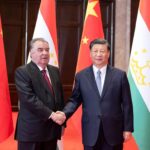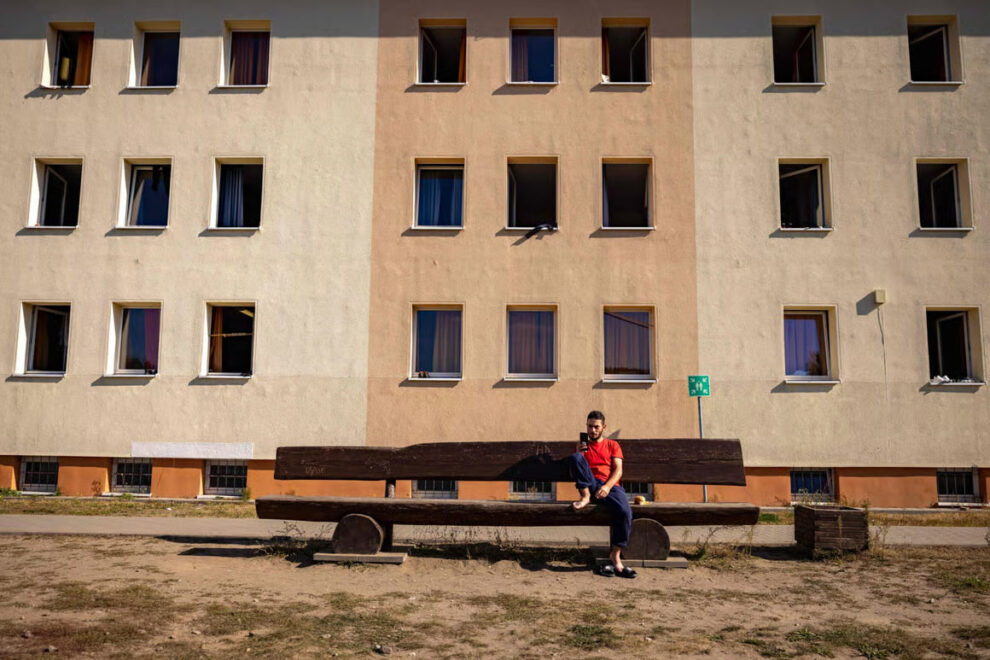A new plan to curb the influx of asylum seekers shows how Germany’s chancellor and his allies are grasping at straws.
BERLIN — Olaf Scholz is getting desperate.
With less than two years left in his first term and his government struggling to cope with a more than 70 percent rise in asylum applications so far in 2023, the famously subdued German chancellor has resorted to hyperbole.
“I don’t want to use big words,” a weary Scholz told reporters in the small hours of Tuesday after hammering out an overhaul of asylum rules with regional leaders, “but I think this is a historic moment.”
He may well be proved right, if only because there’s a fair chance history will mark his failure to achieve more significant reforms as the beginning of his political end.
Scholz has been trying to reduce the number of asylum seekers arriving in Germany for months, an effort many Germans perceive as increasingly urgent amid a recent outbreak of antisemitic incidents, many of which conservative politicians have blamed on migrants. A spike in hate crime towards Jews so unnerved Scholz’s coalition that Vice Chancellor Robert Habeck, who like most of his fellow Greens is a longtime champion of asylum rights, threatened to deport offenders without residency permits.
Germany is on course this year to take in the most asylum seekers since the height of the migrant crisis of 2015, which was triggered by Syria’s civil war. With more than three million refugees, including Ukrainians, already living in the country — the most since waves of ethnic Germans from Eastern Europe fled to Germany after World War II — Scholz faces immense pressure from overwhelmed states and municipalities to relieve the practical burdens they face.
Yet the latest agreement to do so — struck this week between Scholz and the leaders of Germany’s 16 states — shows the extent to which the chancellor and his allies are simply grasping at straws.
The latest package includes a laundry list of cosmetic measures, such as a plan to issue benefits to refugees on debit cards instead of cash, while making new arrivals wait longer to get on German welfare. The “new” initiative also contains familiar promises to accelerate asylum evaluations and deportations while strengthening border controls and pursuing talks with countries in Africa and elsewhere to stem the flow of asylum seekers.
Though the states got what they were really after — more money from the federal government to pay for hosting refugees — the goal of the reducing numbers remains as elusive as ever.
That’s because despite growing financial pressures and public outcry over the influx, there remains a fundamental disconnect between what Scholz’s left-leaning coalition is willing to do and what many believe the crisis demands. More radical proposals, such as establishing an annual asylum quota or shifting refugee processing and evaluations to countries outside the EU, are typically dismissed due to legal concerns, put on the bureaucratic back burner, or both.
Germany has long been the destination of choice for many refugees because its generous approach to asylum has led to the creation of large migrant communities, where newcomers often have connections that ease the transition from their home countries. More than 60 percent of the asylum applications submitted in the EU in the first half of 2023 were made in Germany.
On Tuesday, Scholz declared that European “solidarity” in sharing the burden of hosting refugees was the only viable solution to the problem. It was a refrain first uttered by his predecessor, Angela Merkel, nearly a decade ago. But few countries in Europe seem to have much interest.
As a result, Germany and the EU are caught in an awkward dance, in which Berlin pretends to make tough demands of European partners and Brussels pretends to listen.
The latest installment of this performance involves the so-called New Pact on Migration and Asylum, which has been under discussion since 2020. Under the 1,000-page plan, which was approved by EU countries in October but still needs to pass through a skeptical Parliament to go into effect, asylum procedures would be streamlined at the EU’s external borders.
Frontline states such as Italy would have more leeway to swiftly reject applicants whose prospects for asylum are deemed slim, one of several provisions that sparked much resistance and debate in Germany and elsewhere.
Despite the controversy surrounding the EU plan, it’s far from certain it would make much of a difference in limiting migration. For it to succeed, the EU would have to convince the countries the migrants are fleeing from to take them back if they aren’t granted asylum; it will also have to cut deals with authoritarian states in northern Africa to keep asylum seekers from trying to cross the Mediterranean, a strategy many find unsavory.
While Germany would ostensibly be the main beneficiary of the EU deal, its approach towards the talks reflects the government’s deep reservations about taking a harder line on asylum.
Indeed, Berlin’s reluctance to embrace harsher provisions, such as those that allow for the detention of asylum seekers at the EU’s external borders until their cases are decided, is one of the main reasons that negotiations over the pact dragged on.
For many in Scholz’s left-leaning coalition, which in addition to his Social Democrats (SPD) includes the Greens, the tougher approach outlined in the pact was a bridge too far.
Until Germany began feeling the brunt of the latest influx of refugees, that is.
The recent surge has pushed many German regions and municipalities to the brink. Local officials complain that they have neither the housing nor the personnel to handle the more than 250,000 asylum seekers who have arrived in the country so far this year.
The German public has also grown increasingly uneasy. More than 70 percent of the population expresses dismay over the government’s handling of migration, according to recent polling. This has helped propel record support for the far-right Alternative for Germany (AfD) party.
Frustration over the government’s migration policy also contributed to last month’s historic rout of Scholz’s SPD, which recorded its worst results in elections in the states of Hesse and Bavaria in more than a century.
The AfD’s surge convinced many in the SPD and Greens to harden their stance on asylum. Nonetheless, Scholz’s dilemma remains that many those parties will not countenance more radical reform. The center-right Christian Democrats have tried to step into the void, proposing more sweeping overhauls in an effort to win back AfD voters.
During this week’s negotiations, for example, Christian Democrat state leaders pushed for the idea of establishing asylum centers in third countries, similar to what the UK has attempted in Rwanda. It’s an old idea, one first raised by an SPD interior minister about 20 years ago. But it never went anywhere because many on the political left considered it a violation of refugees rights.
In the end, Scholz agreed to commission a study to “explore” the legal ramifications of the idea, the German political equivalent of “Don’t call me, I’ll call you.”
Unable to pursue bold action, Scholz’s only remaining option is to try to keep up appearances. Last month, he told German magazine Der Spiegel it was time to begin deporting asylum rejectees “on a grand scale.” For those familiar with the legal and practical hurdles of doing so, however, it was just another empty pledge.
Roughly 300,000 people whose asylum applications have been rejected remain in Germany. The challenges Germany faces in deporting them were on full display last week, when Scholz traveled to Nigeria in a quixotic attempt to convince that country’s leaders to take back 14,000 of their compatriots.
The main hang-up preventing the deportation of most? They lack passports. Many Nigerian migrants dispense of their papers in the knowledge that doing so complicates deportation.
At a press conference following his meeting with President Bola Tinubu, Scholz outlined in German what the two leaders had discussed. When he got to his last, and for Scholz most important point — migration — the Nigerian removed the headphones he’d been wearing for the translation.
Scholz said that while he was convinced that migration was a central question for all nations, “it’s also true that the importance of this issue is greater in some countries than others.”
Source: Politico








































